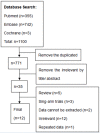Systematic review and meta-analysis of patient-controlled sedation versus intravenous sedation for colonoscopy
- PMID: 26884890
- PMCID: PMC4723735
Systematic review and meta-analysis of patient-controlled sedation versus intravenous sedation for colonoscopy
Abstract
Background: Patient-controlled sedation (PCS) has been suggested as an alternative method for sedative colonoscopy. However, as any new techniques, PCS introduction as a potential alternative to traditional intravenous sedation (IVS) has brought about challenges. To evaluate the advantages and disadvantages between PCS and IVS more comprehensively, we conducted a systematic review and meta-analysis of the published literature.
Methods: Several databases were searched from inception to 1 April, 2015, for trials comparing PCS with IVS for colonoscopy. The outcomes of interest included time for cecal intubation, rate of complete colonoscopy, dose of sedative drugs used, pain scores, recovery time, complications. Inconsistency was quantified using I (2) statistics.
Results: In all, 12 trials were finally selected (1091 patients, with 545 in the PCS group, and 546 in the IVS group). The total propofol used, time for cecal intubation, rate of complete colonoscopy and pain score had no statistical difference between the two groups. However, PCS showed a reduction in the recovery time, incidence of oxygen desaturation and hypotension. The rates of other complications and patients' willingness to repeat the same sedation had no statistical difference between the two groups.
Conclusion: PCS is as feasible and effective as traditional IVS for colonoscopy, and there is a tendency that PCS shows its superiority in recovery time, incidence for oxygen saturation and hypotension.
Keywords: Sedation; colonoscopy; intravenous sedation; meta-analysis; patient-controlled sedation.
Figures







References
-
- Jover R, Herraiz M, Alarcon O, Brullet E, Bujanda L, Bustamante M, Campo R, Carreño R, Castells A, Cubiella J, García-Iglesias P, Hervás AJ, Menchén P, Ono A, Panadés A, Parra-Blanco A, Pellisé M, Ponce M, Quintero E, Reñé JM, Sánchez del Río A, Seoane A, Serradesanferm A, Soriano Izquierdo A, Vázquez Sequeiros E Spanish Society of Gastroenterology; Spanish Society of Gastrointestinal Endoscopy Working Group. Clinical practice guidelines: quality of colonoscopy in colorectal cancer screening. Endoscopy. 2012;44:444–451. - PubMed
-
- Williams CB. Comfort and quality in colonoscopy. Gastrointest Endosc. 1994;40:769–770. - PubMed
-
- Iber FL, Sutberry M, Gupta R, Kruss D. Evaluation of complications during and after conscious sedation for endoscopy using pulse oximetry. Gastrointest Endosc. 1993;39:620–625. - PubMed
-
- Heuss LT, Drewe J, Schnieper P, Tapparelli CB, Pflimlin E, Beglinger C. Patient-controlled versus nurse-administered sedation with propofol during colonoscopy. A prospective randomized trial. AM J Gastroenterol. 2004;99:511–518. - PubMed
-
- Saunders BP, Fukumoto M, Halligan S, Masaki T, Love S, Williams CB. Patient-administered nitrous oxide/oxygen inhalation provides effective sedation and analgesia for colonoscopy. Gastrointest Endosc. 1994;40:418–421. - PubMed
Publication types
LinkOut - more resources
Full Text Sources
Medical
Miscellaneous
